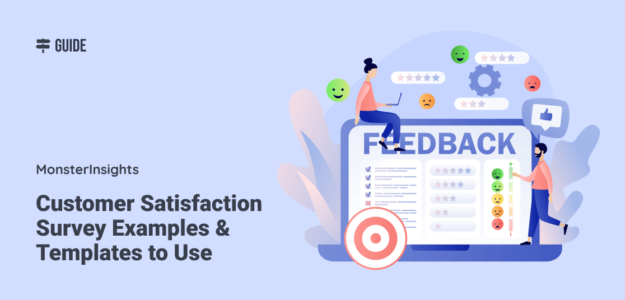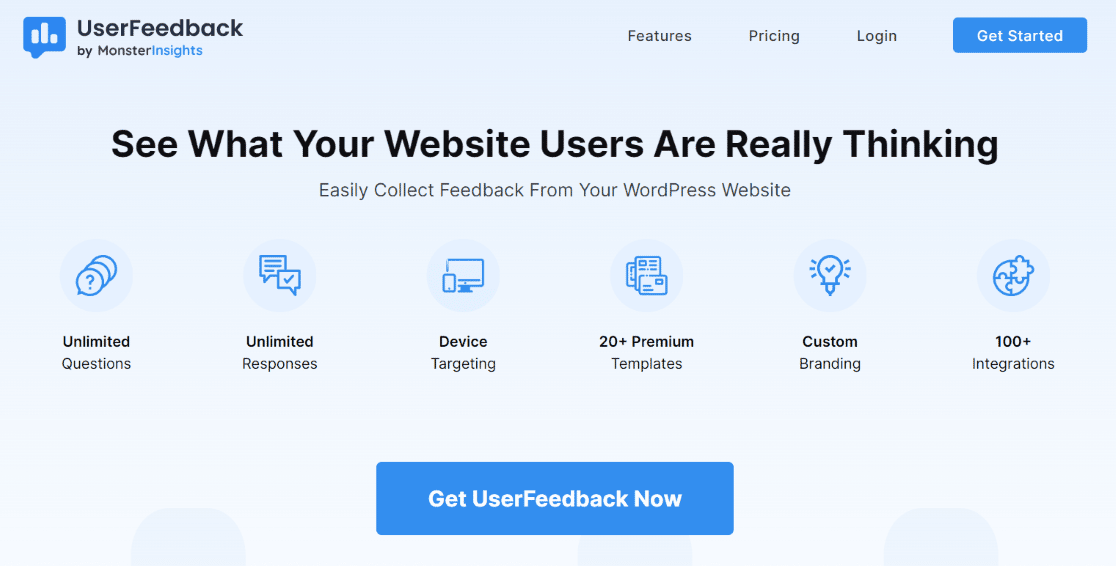Are you looking for customer satisfaction survey examples and templates to use for your business?
Understanding how satisfied your customers are is crucial for businesses to improve their products and services.
A good way to gauge customer satisfaction is through surveys. By asking the right questions, you can gather relevant information and use it to better your business and meet customers’ expectations.
In this article, we’ll go over different types of customer satisfaction survey questions with templates you can start using now. We’ll also look at survey examples from actual companies and share some best practices to keep in mind for your customer feedback surveys.
Ready to dive in?
- What Is a CSAT Survey? Why Use One?
- Customer Satisfaction Survey Templates
- Customer Satisfaction Examples + Tips
What Is a Customer Satisfaction Survey?
A customer satisfaction survey (CSAT) is a questionnaire designed to give you insights into how your customers feel about your business, products, and services.
To make informed improvements, you need to gather feedback on various aspects of your business, such as the shopping experience, pricing, product selection, and much more.
Why Use a Customer Satisfaction Survey?
Using a survey to understand customer satisfaction helps you learn about your customer’s needs, identify areas for improvement, segment your customer base by survey responses, and more.
By using rating scales and tracking metrics, businesses can see how well they’re meeting customer expectations and set goals to strive for.
Customer satisfaction surveys provide valuable feedback that you can use to improve your business and create a positive experience from the moment a customer interacts with your brand to the point they become a loyal customer.
Customer Satisfaction Survey Templates
When it comes to customer success and satisfaction, 3 main customer experience surveys are commonly used.
- Net Promoter Score (NPS) Survey – Measures customer loyalty to your brand.
- Customer Effort Score (CES) Survey – Measures how easy it is for customers to complete an action or use your business.
- Customer Satisfaction (CSAT) Survey – Measures how happy customers are with your product/service, their overall experience, or any aspect of your business.
There are tons of customer survey questions for a variety of purposes, such as performing market research, examining competitive providers, exploring new product features, and lots more. In this article, we’ll be focusing on customer satisfaction survey questions.
First, we’ll look at the tool we’ll be using for our feedback survey templates. Next, we’ll go over different types of questions and the customer feedback they provide to help you decide which questions to ask for the answers you’re after.
How to Use Our Survey Templates
For all of our customer survey templates, we’ll be using UserFeedback. It’s the best WordPress plugin for customer feedback. Use its short popup surveys to find out what your visitors really think. Make more money, increase engagement, and grow your business faster with candid customer feedback.
UserFeedback already comes with a ton of awesome online survey templates, and it’s super beginner-friendly. Plus, you can use our templates below as a guide for your own custom surveys.
The best part? It has seamless integration with MonsterInsights to track your form submissions and deliver reports right inside your WordPress dashboard.
Get started with UserFeedback now!
Want to try it out first? Check out the free version.
Pro tip: Looking to add extensive surveys and other form templates for your WordPress site? Check out WPForms, the best survey form builder available.
Questions Types + Templates to Measure Customer Satisfaction
1. Star Rating Questions
Using a star rating question is a standard way to measure overall satisfaction. It provides quantifiable data and a format that customers are familiar with.
You can find your CSAT score by dividing the number of satisfied customers (those who rated 4 or 5 stars) by the total number of respondents.
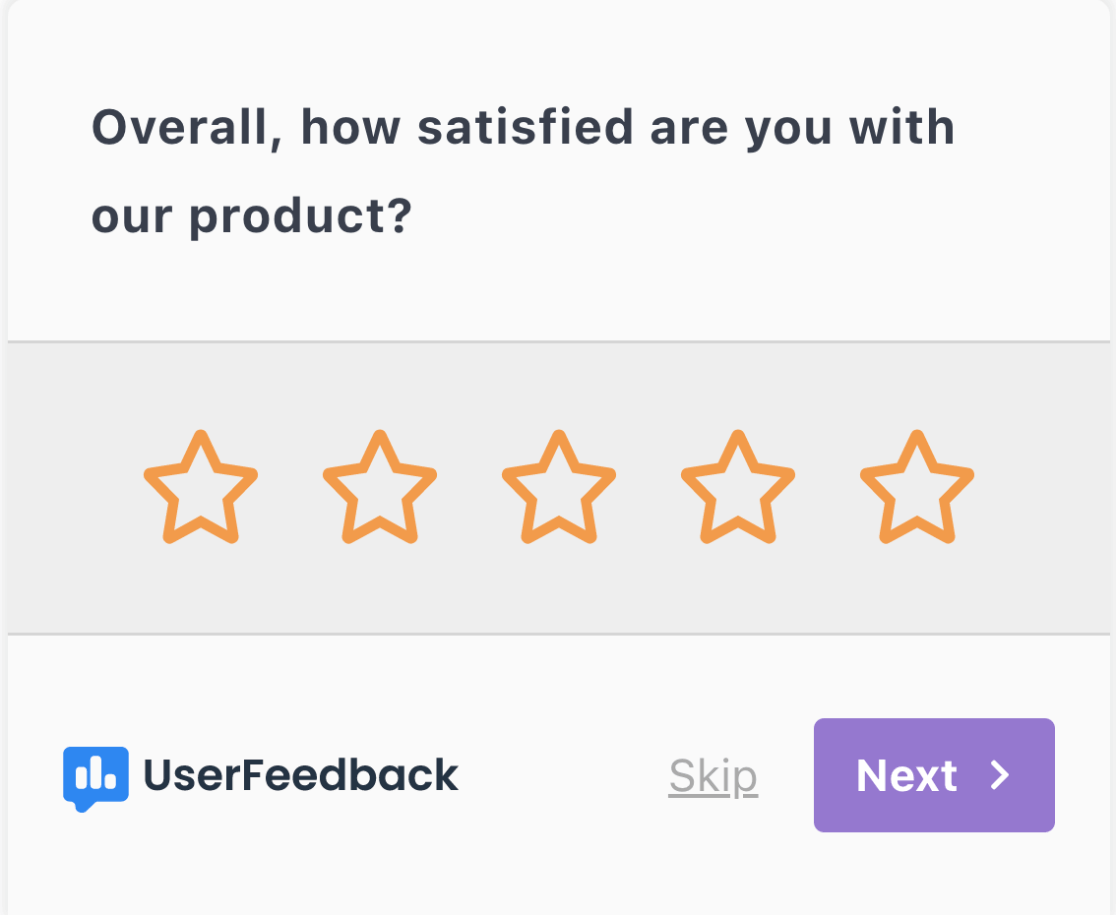
Although it’s an excellent jumping-off point for determining customer satisfaction levels, it also doesn’t paint the full picture.
Customers may have an isolated experience that affects their answers, but this question alone won’t uncover it. Also, some customers may lean away from choosing an “extreme,” even if that is truly how they feel.
How to make it: Use the B2B Satisfaction Survey template in UserFeedback, or check out our full tutorial on how to create a customer satisfaction survey on WordPress.
2. Standard Likert Scale Questions
A Likert scale survey question is most often used when you want to create a Net Promoter Score survey (NPS). However, it can also be used to measure customer satisfaction.
Similar to a star rating, it gives you measurable data that you can use to find a customer satisfaction score.
Using this type of question allows a bigger range of sentiments, which may help with customers being wary of choosing an extreme. It can also help you better pinpoint when satisfaction levels decrease, even slightly.
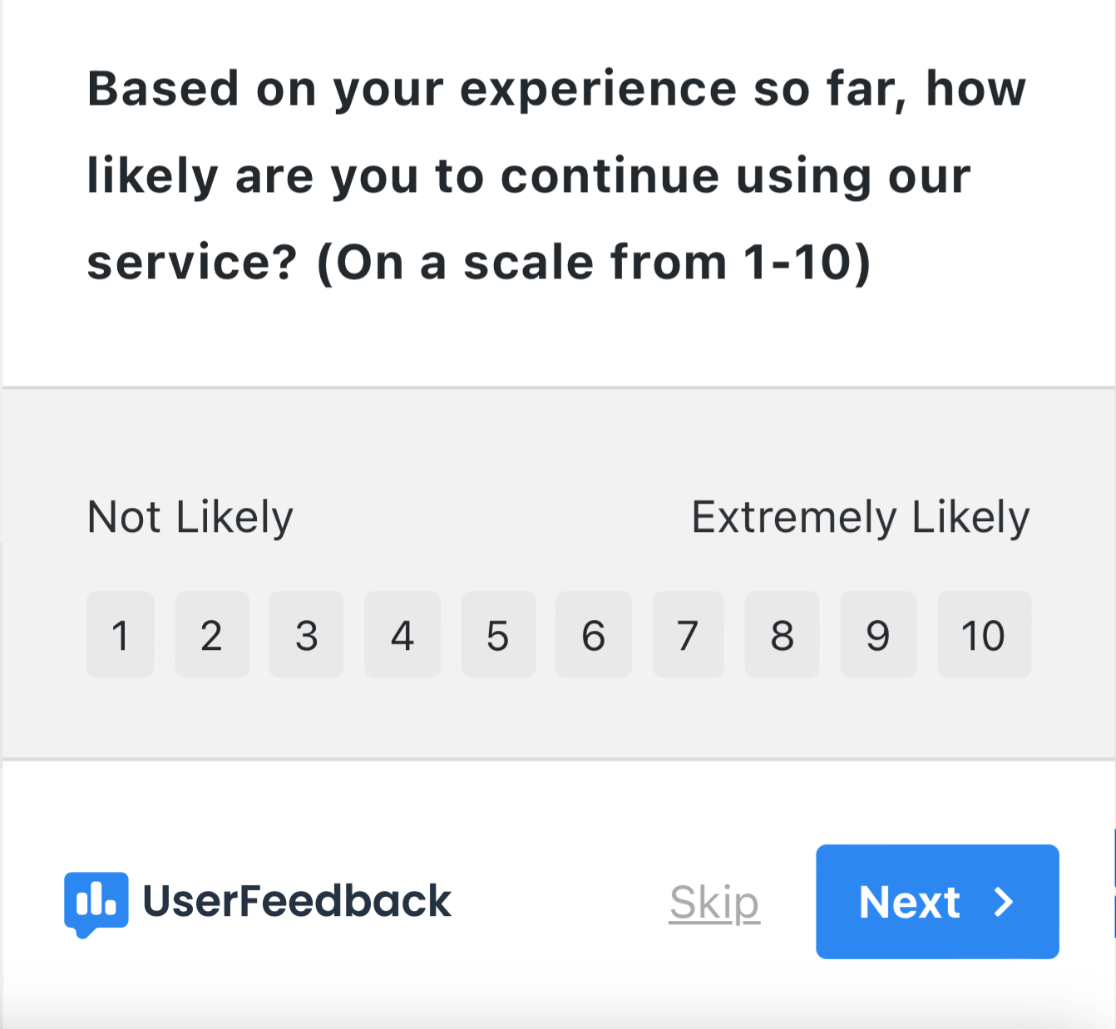
How to make it: Use the NPS Survey template (or question type) in UserFeedback.
3. Binary Likert Scale Questions
Another option is a binary Likert scale. It’s similar to both of the previous question types. However, in this case, you remove any neutral rating options to ensure that the answer tells you whether the customer is satisfied or unsatisfied.
It still provides some range and may help find overall customer sentiments faster.
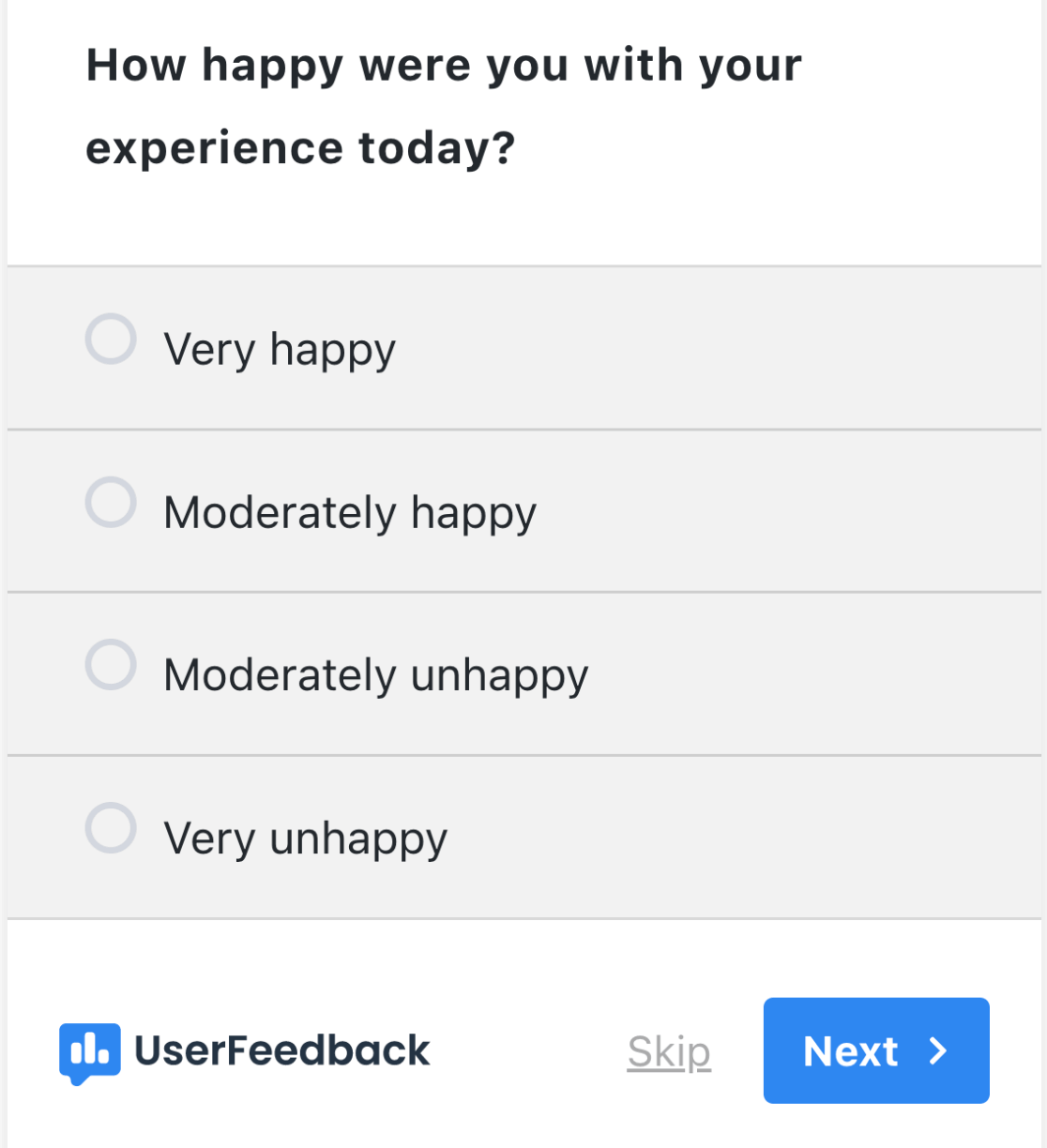
Again, this question is helpful for getting quantifiable data, but it won’t give you context for why your customers are at that satisfaction level.
How to make it: Use the Website Experience template in UserFeedback and delete the neutral answer choice.
4. Yes / No Questions
Another way of getting binary answers is by using a simple yes/no question. The pro here is that it’s quick and easy for customers to answer, which means you’ll likely get a better response rate.
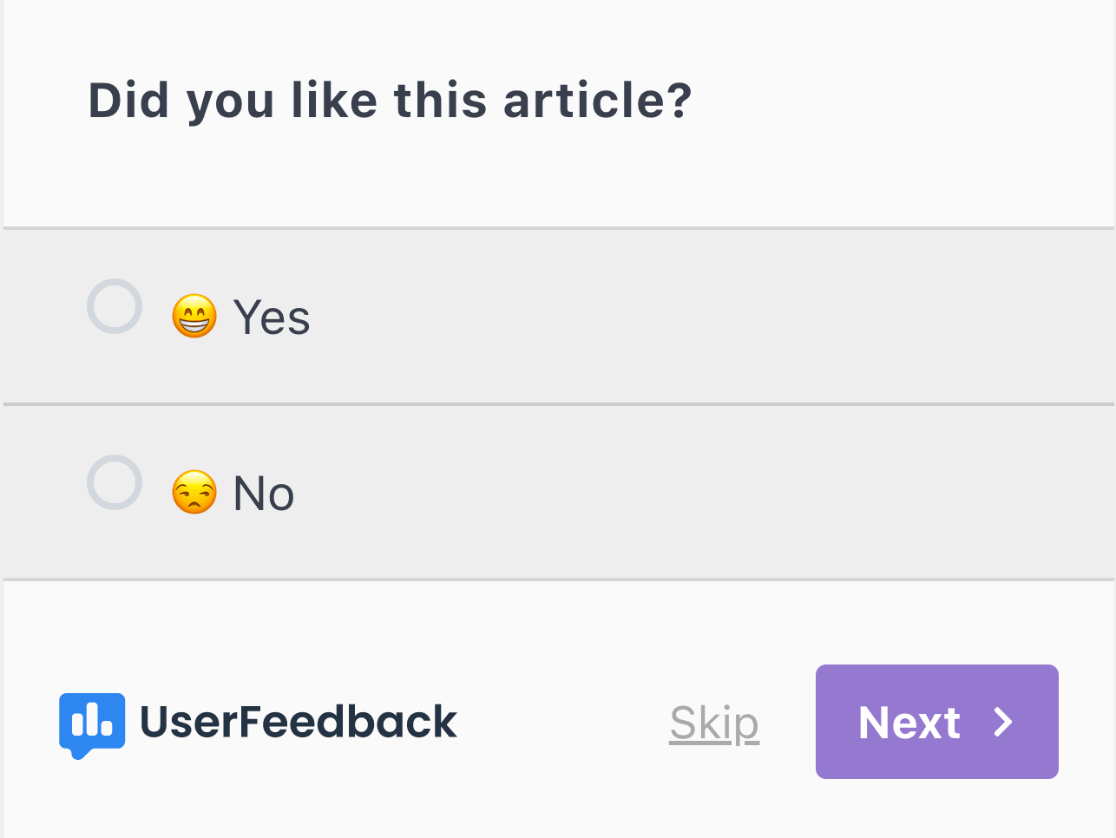
The downside is that you still won’t get context with this question, and you don’t get any data about the customer’s range of satisfied vs. dissatisfied. That said, it can be a great way to get a general sense of your customers’ feelings.
It’s also particularly useful for maximizing the response rate to optimize highly specific things, such as individual blog posts or item pricing.
How to make it: Use the Content Engagement template in UserFeedback.
5. Multiple-Choice Questions
Although this type of question is more leading, it can provide helpful customer insights into which aspects of your business are most successful and help uncover trends.
You can ask this type of question about what your customers like best. Or, reverse it to find out what they liked least and identify pain points.
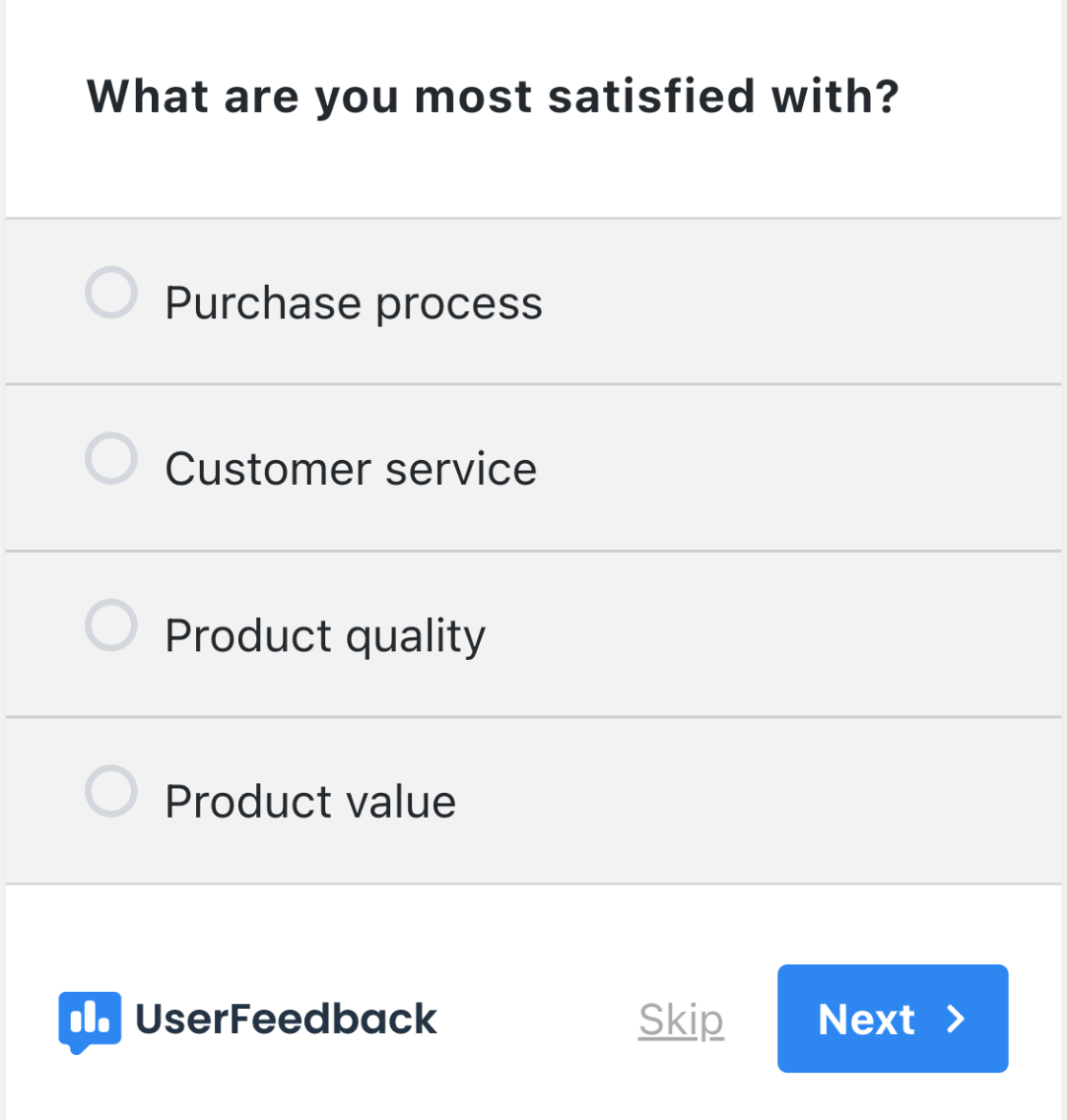
Pro tip: If you’re using UserFeedback for your surveys, you can use Conditional Logic to determine what question shows next, depending on how the first was answered.
For example, if you asked a yes / no question first, the next question could be multiple choice with yes respondents being asked, “What were you most satisfied with?” and no respondents being asked, “What were you least satisfied with?”
How to make it: Use the Start from Scratch template in UserFeedback and choose Radio Buttons as the question type.
6. Checkbox Questions
Similar to multiple choice, checkbox questions give customers multiple answer choices, but here, they can choose more than one. This is useful when you want to get general feedback about a number of different things.
It can also be helpful in pinpointing problems and seeing trends when used in combination with other questions. Like multiple-choice, you can also reverse it to ask what the customer was not happy with.
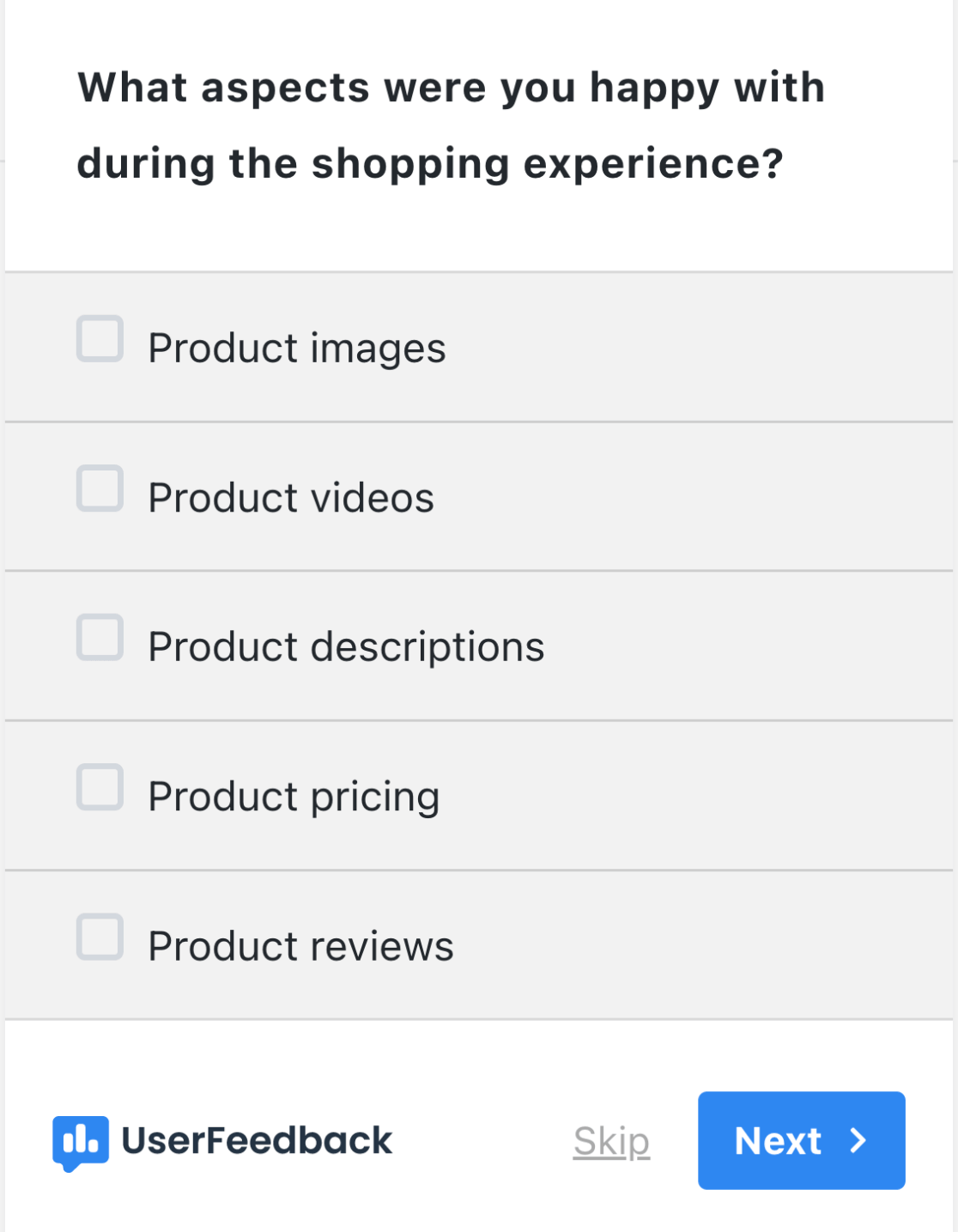
A multiple choice with lots of possible answers can make it hard for customers to choose, and they may just give up and pick the first one they notice. Checkboxes make it much easier for customers to decide if they did or didn’t like a number of consecutive items.
How to make it: Customize UserFeedback’s Product Offering Intelligence template to use a checkbox question followed by an email capture.
7. Open-Ended Questions
This is the real money-maker. Although you likely won’t get as many responses, the value of the responses you do get can greatly make up for it.
Your customers get to tell you in their own words what would make them more satisfied, which helps you improve your business. It also provides context for your CSAT scores.
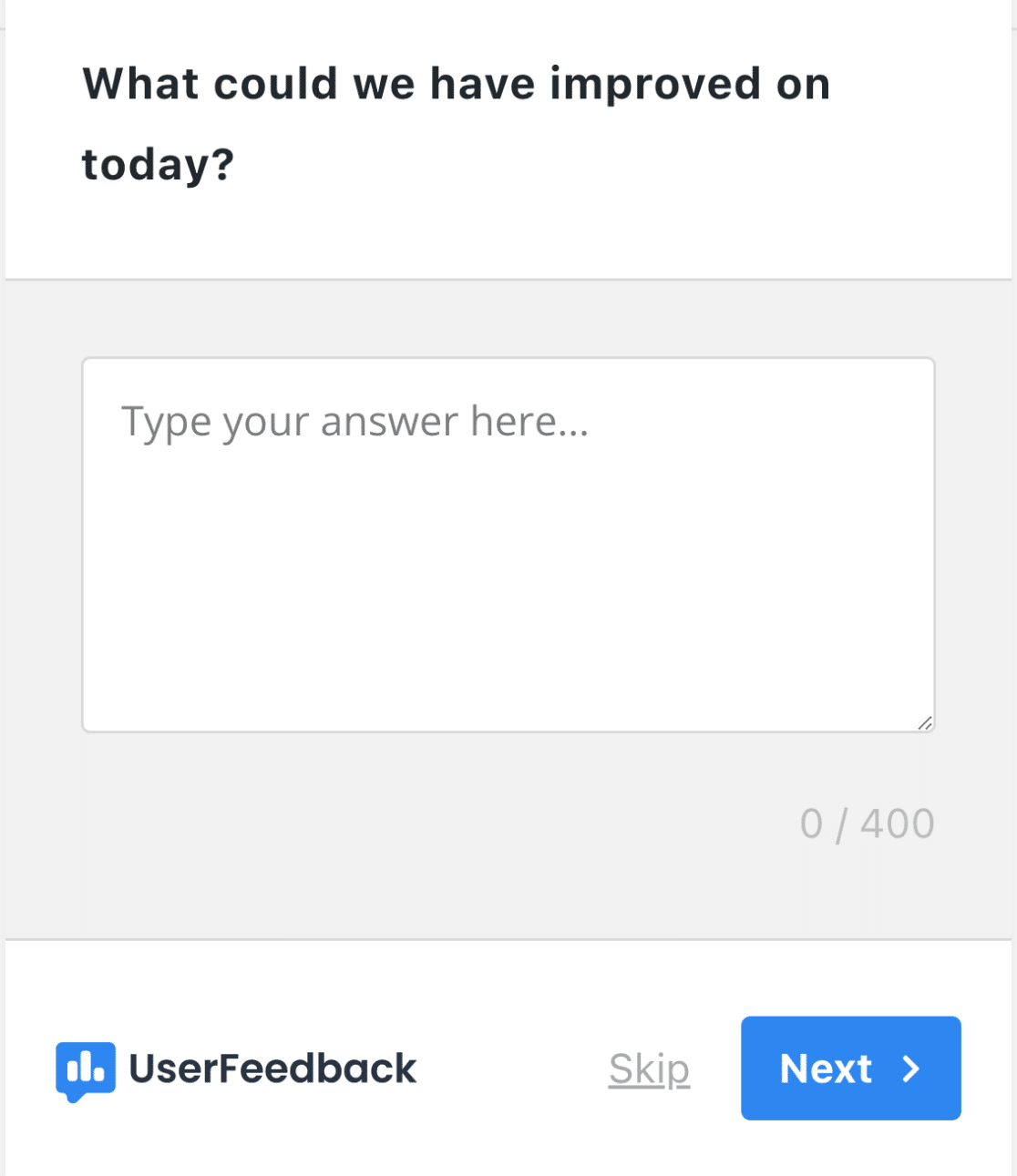
Although open-ended questions give you very valuable information, they don’t provide any quantifiable data, so it’s best to combine them with other more metric-focused questions to get the full picture.
How to make it: Many of the UserFeedback templates include an open-ended question to collect more feedback at the end of a survey. You can also use the Start from Scratch template and choose Long Answer or Single Text Field as the question type.
Download UserFeedback for your WordPress site now to access all the question types and templates! (Or get started with the free version).
Customer Satisfaction Survey Examples + Tips
Now that you’re familiar with the types of feedback questions, let’s take a look at real-world customer satisfaction survey examples while we go over survey design best practices, tips, and things to avoid.
Best Practices for Creating a Customer Satisfaction Survey
Here are the best practices we’ll go over in detail while looking at survey examples from real companies.
- Use Targeted Surveys
- Add an Incentive
- Don’t Ask for Too Much
- Ask the Right Questions
- Show You Care
- Use One Question at a Time
- Include Your Branding and Message
Survey Examples from Real Brands to Inspire and Improve Upon
Use Targeted Satisfaction Surveys
One of the most important things to think about when you’re making a customer survey is when, where, and who you want to target. If you’re trying to find your overall CSAT score, then displaying a survey on every page of your site may make sense.
However, as you’ve learned, customer satisfaction feedback can be about any aspect of your business, which is why it’s important to think about your target audience and specific touchpoints in the customer journey, such as during onboarding.
UserFeedback’s survey tools and targeting features make this easy. You can display different survey widgets by page or post, tags, logged-in users, URLs, device type, or even by what the referring URL is.
You can also schedule surveys to control when you collect feedback, like during a sale or promotion, and use conditional logic to change your questions depending on the customer’s answer to a previous one.
Asking customer satisfaction survey questions after visitors made a purchase or interacted with your support team are common scenarios where you can ask more targeted questions to gather specific feedback.
Linking your surveys to the user experience helps you target the niche information you’re after and avoid customers receiving numerous surveys that don’t relate to them.
Let’s look at an effective example of this.
1. TurboTax
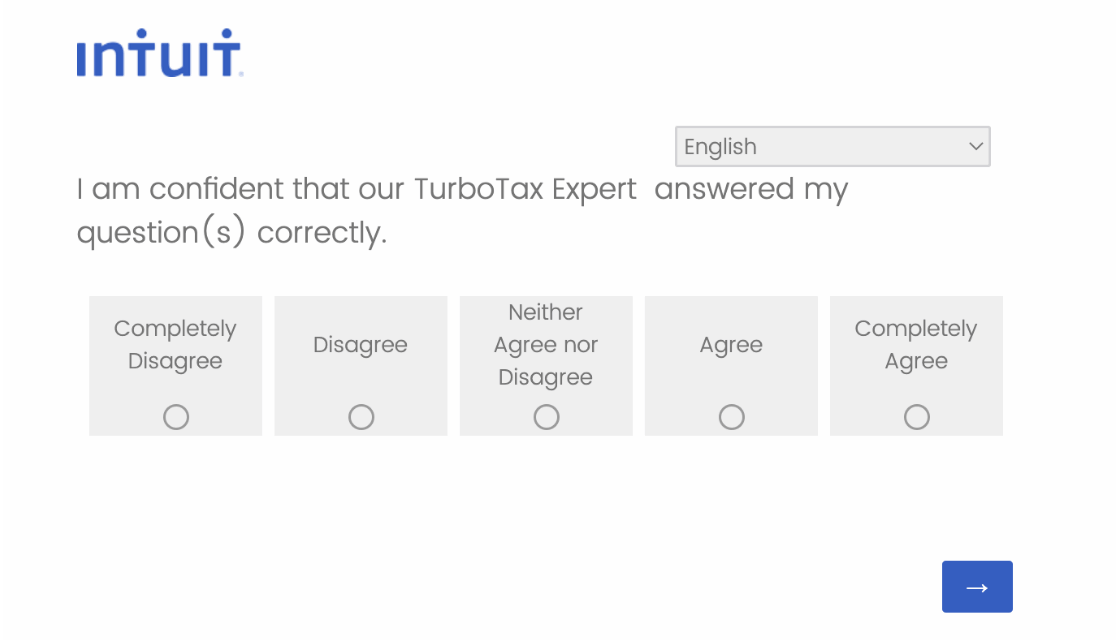
In this follow-up survey from TurboTax, the company asks specific satisfaction questions about the customer support live chat that is offered through their premium accounting service.
The survey is only triggered when a premium subscriber actually uses the service, which allows them to ask a string of highly specific questions about the service experience and guarantees they won’t get skewed feedback from customers that have no relationship with this particular feature.
Add an Incentive for Your Customer Surveys
Adding an incentive is an awesome way to encourage customers to fill out a survey. It’s especially good if you’re planning to use a longer survey, which is harder to get customers to fill out.
Using giveaways is a good way to offer an incentive that doesn’t require you to commit to a reward for every customer. And remember, incentives don’t necessarily have to be monetary.
It could be a promise to donate a certain amount to a charity if X number of people take the survey, a free digital download, or early access to a new product drop. Let your creativity flow when adding an incentive to your survey!
You could also advertise an online contest for your survey as an incentive, which has the bonus of increasing your social media presence. Or, use a gift card or reward program as a survey motivator to encourage your visitors to use your business again, thus increasing customer retention.
Let’s look at some example surveys that use incentives.
2. Lyft Customer Survey
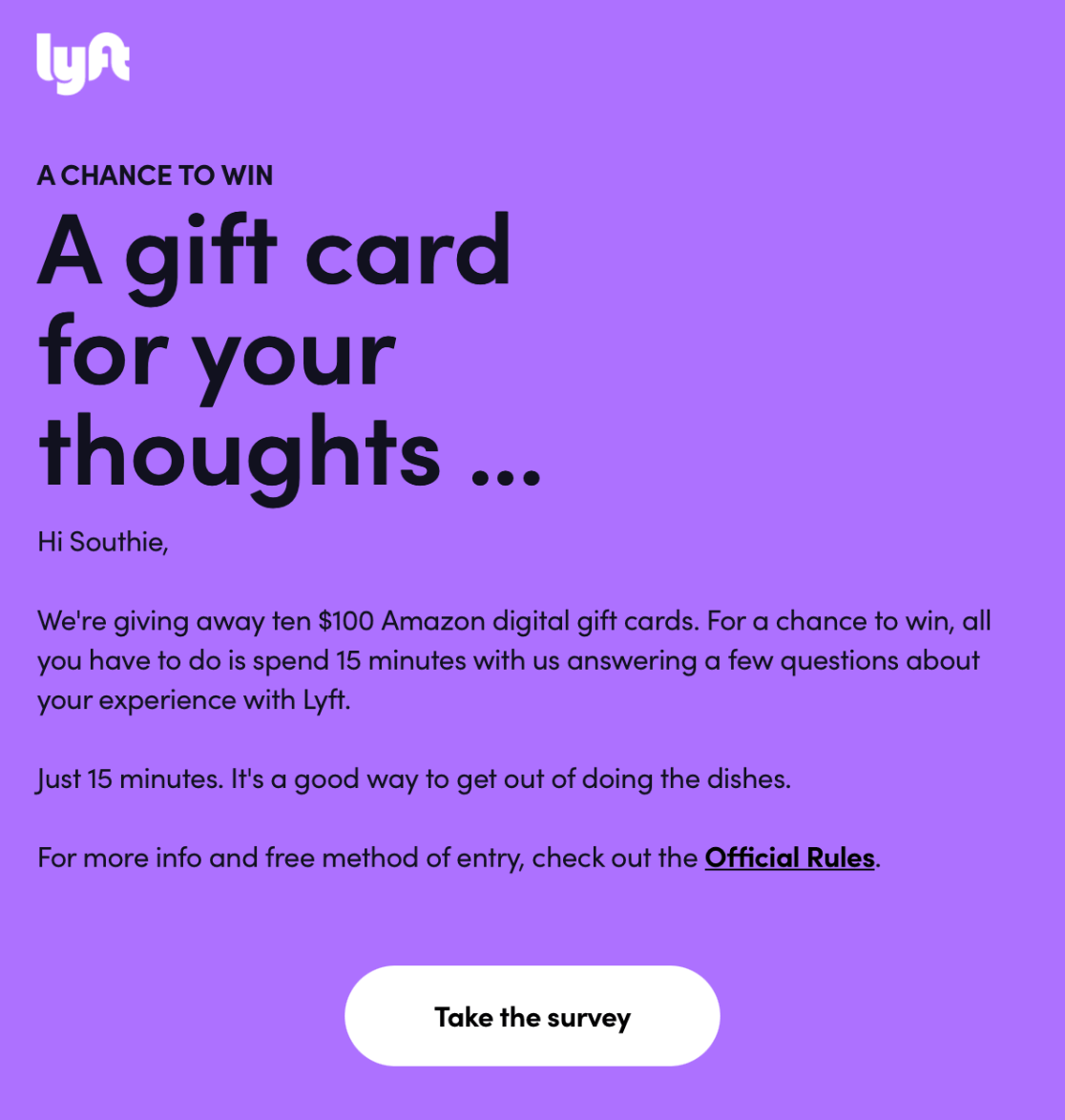
Lyft is definitely putting the focus on the incentive, which is great for getting customers to respond. We also like that they tell customers upfront how long it’s going to be and what it’s about.
15 minutes is a pretty long survey by most standards. But, by offering a larger incentive and telling customers what to expect, they leave it in the customers’ hands to decide if it’s worth it. This mitigates any negative feelings that could arise if customers felt “tricked” into that long of a survey.
Now, let’s look at another incentivized survey that’s not quite as straightforward.
3. Hilton Hotels

We like the survey reward, and the tagline is catchy and enticing. It uses imagery to focus on the incentive, which is powerful for encouraging users to complete the questionnaire.
That said, we don’t like that they don’t tell us how long it’s going to take or what it’s about. Because of the incentive, we assume it’ll be a long customer satisfaction survey.
However, we actually discovered that the survey wasn’t about Hilton Hotels at all and was pretty short – just a few demographic questions. If customers knew that upfront they would probably be much more likely to complete the survey.
Don’t Ask for Too Much in Your Survey
Make sure that you’re not asking your customers to do too much. Keeping your surveys short and focused will usually bring better results.
With UserFeedback’s unlimited surveys and unlimited questions, it’s easy to want to ask your customers about everything at once. Just remember, even a survey should be customer-centric with a focus on creating positive customer experiences.
This is another way that incentives can help. If you’re planning a longer survey, a reward can help offset the time. If customers fill out a long survey and don’t see any value for themselves, it can leave a bad taste, which is the exact opposite of what you’re trying to accomplish.
Let’s look at a couple of examples to demonstrate this.
4. Wealthfront
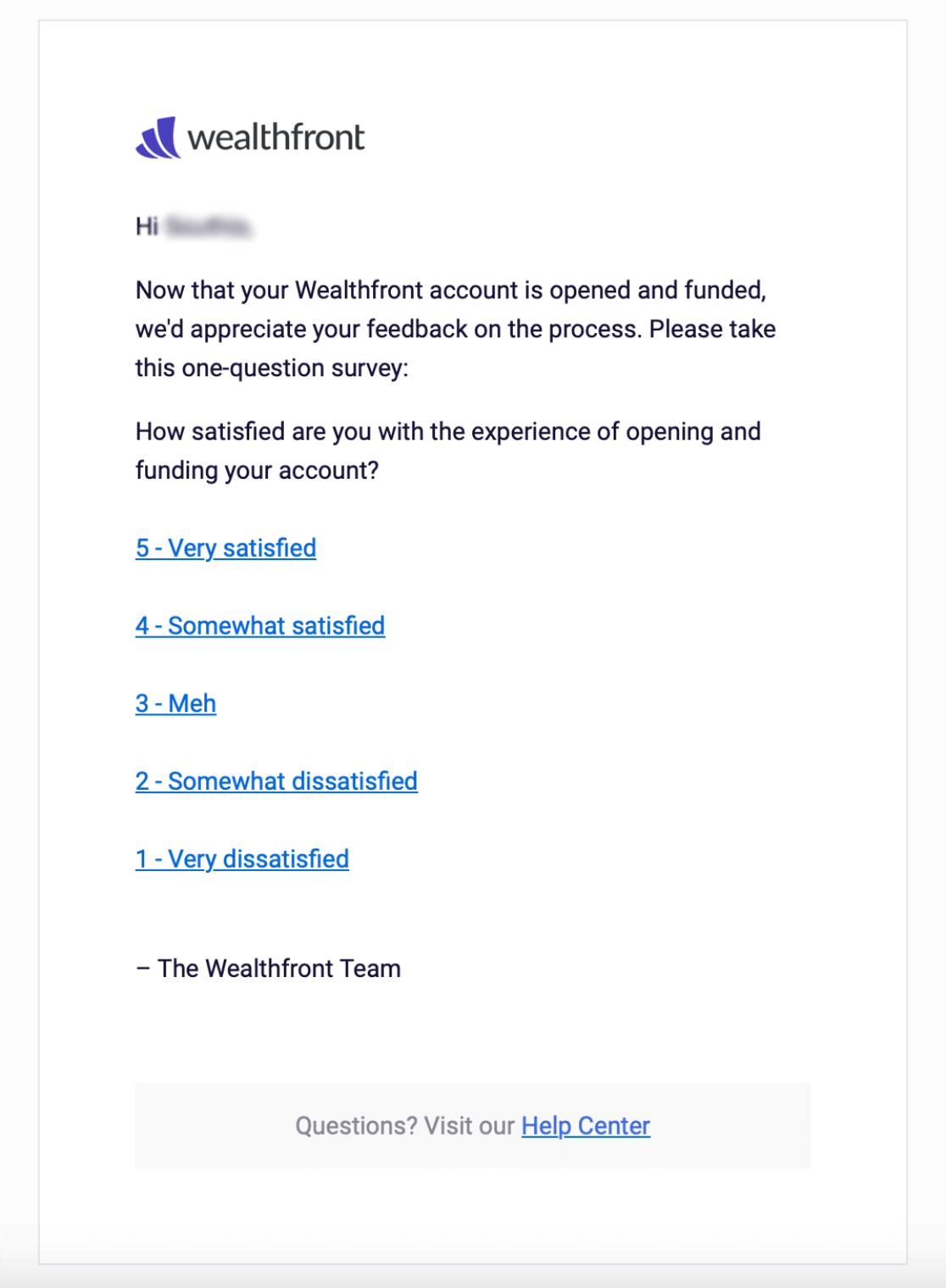
This new client satisfaction survey is short, focused, and personalized, which is why we like it. If you notice, the answers are a link, which allows you to provide other feedback in an open-ended question format.
It’s not the most robust survey, but it’s targeted at new users. Unlike existing customers, new users may not feel enough brand loyalty to fill out a long survey.
It’s to the point and excellent for maximizing responses to find the CSAT score of new customers entering the business’s lifecycle.
Now, take a look at the other end of the spectrum.
5. Amazon
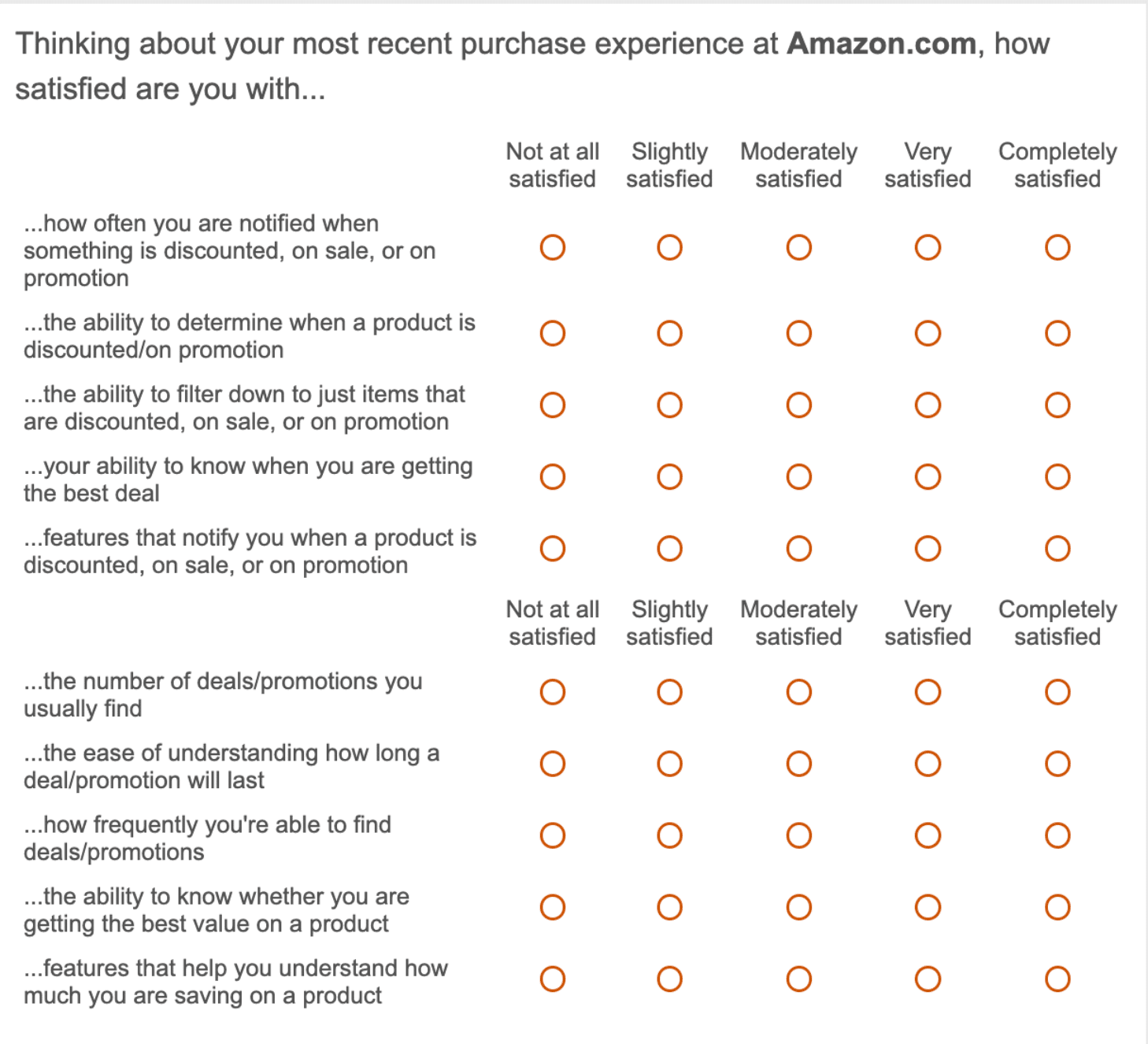
This survey from Amazon is only one tiny piece of a very long survey… 68 questions to be exact.
It’s definitely gathering tons of niche data by asking laser-focused questions that are targeted at shoppers who have recently purchased certain product types.
That said, it’s just too long for one sitting when the value for customers doesn’t match the effort. The incentive was a $5 gift card, and it was advertised as taking 10-15 minutes to complete, but we found that to be a very generous estimate.
The result is that customers may get halfway through and feel tricked or even give up before submitting the survey. Collecting all that information is great over time, but you don’t want your customers to feel overwhelmed.
Ask the Right Customer Satisfaction Questions
As we’ve talked about before, asking the right questions for the answers you’re after is essential. Plus, it helps you stay focused and not get carried away with too many questions.
We usually suggest a combination of metrics-based survey questions along with an open-ended question to gather suggestions. But, it all depends on your business and your needs.
Luckily, UserFeedback makes it easy to ask all types of different customer survey questions on your WordPress website. Use easy pre-made templates or totally custom questionnaires.
Let’s look at two very different examples that both ask the right questions.
6. Mindpath Health
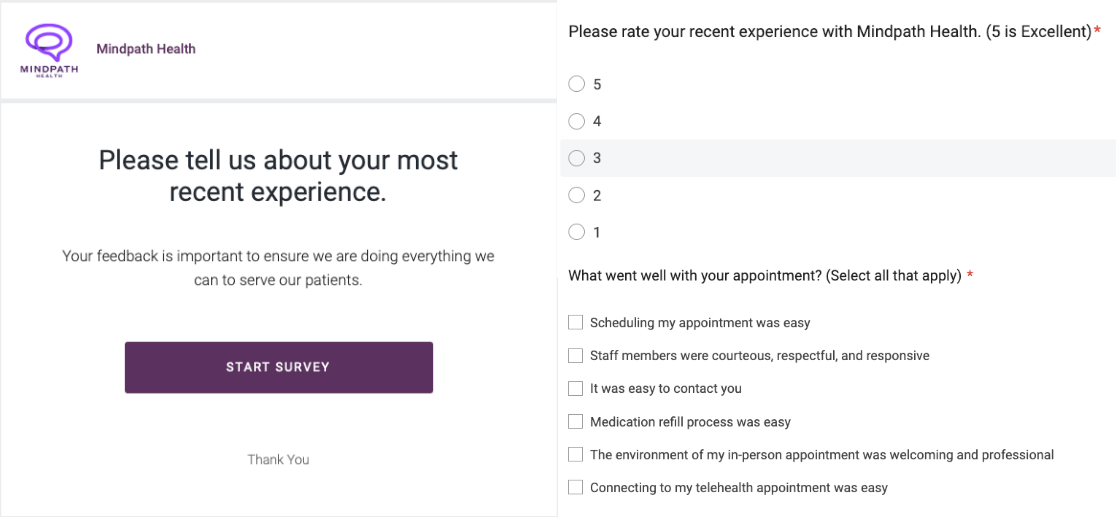
This patient survey from a healthcare company is a great example of a metrics-focused satisfaction survey. The first question provides quantifiable data that can be used to find a CSAT score.
Although the second question isn’t a long answer, using checkboxes and a variety of items makes it a bit more open. It leads the customer to think about their satisfaction with specific aspects, without forcing them to choose the best or worst.
Now, let’s look at this less obvious example.
7. The Nudge
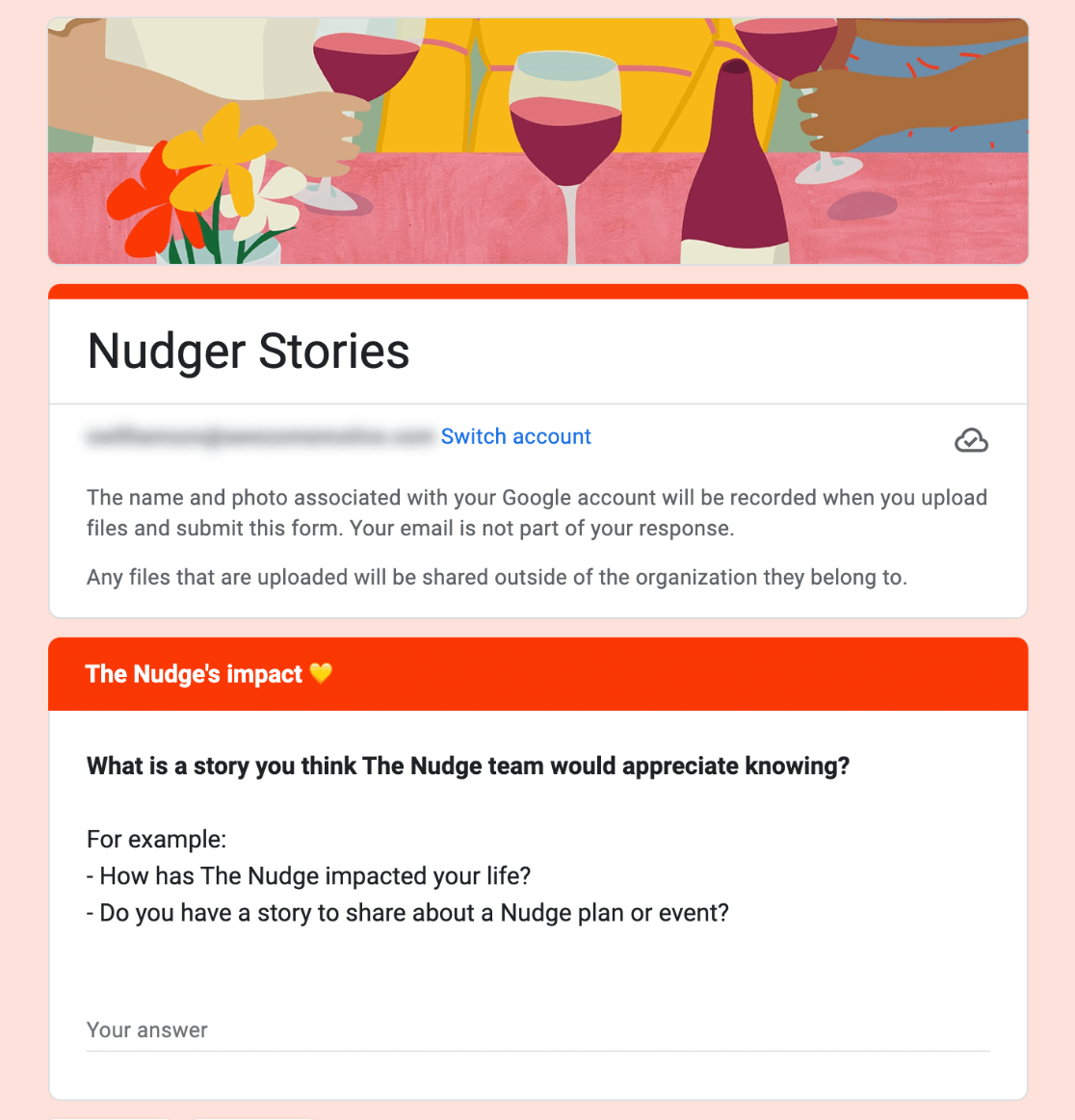
This is a survey from an app-based company that provides activity plans and events for metropolitan areas. It’s different than most of the customer satisfaction surveys we’ve examined because it doesn’t ask any quantifiable questions.
However, they give examples of the type of answers they’re looking for to help guide customers. These make it clear that they’re not looking for suggestions or metrics. Instead, they’re likely trying to gather marketing testimonials from satisfied customers.
At first look, it could look like it’s not a very thorough survey, but when you think about the context of what they need out of it, it’s actually perfect for the job.
Show You Care When Asking for Feedback
Everyone likes to be heard, and that includes your customers. Adding a touch to show that you really do value their feedback and time can go a long way.
When customers know how seriously you take their feedback and that you use it to improve your business, it can make them much more inclined to answer a survey and improve your customer churn.
Let’s see how this works on 2 different surveys.
8. Delta Dental
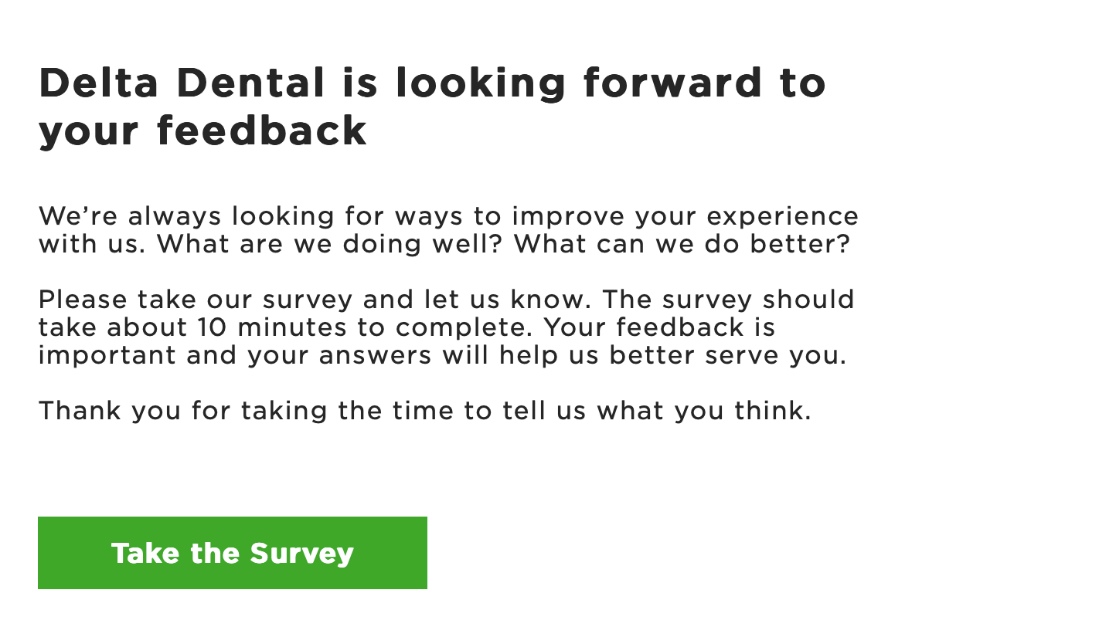
Although it isn’t as eye-catching as some CSAT surveys we’ve seen, it feels sincere because they make a point of telling you why they’re asking for feedback, what they plan to do with it, and how important it is to them.
Plus, they’re upfront about how long it will be and provide a thank you, which shows customers that their effort is valued. The design simplicity actually amplifies the longer, feelings-based text.
Next, let’s look at this shorter example that has the same concept.
9. JSX Flights
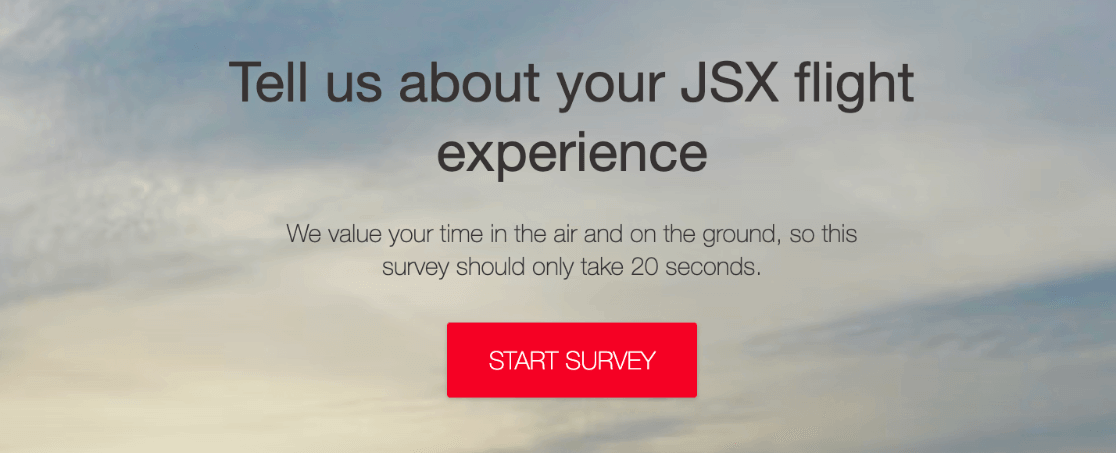
Although short, this survey example still tells customers they care. The company shows how much they care about their customers’ time by explicitly saying that the survey will only take 20 seconds because “we value your time.”
The survey is only two questions long and starts with a metric question followed by an open-text question. Because they followed through on what they said, it creates a positive experience for the customer and builds trust.
Use One Question at a Time in Your Survey
This isn’t a hard and fast rule. Plenty of awesome customer satisfaction surveys ask all their questions on one form. However, using a one-at-a-time format for your satisfaction survey can make it more conversational and increase engagement.
This is another way that UserFeedback helps. The format is simple questions in a non-intrusive popup that moves one at a time to keep visitors engaged.
Let’s look at some examples of this survey style.
10. Five Guys
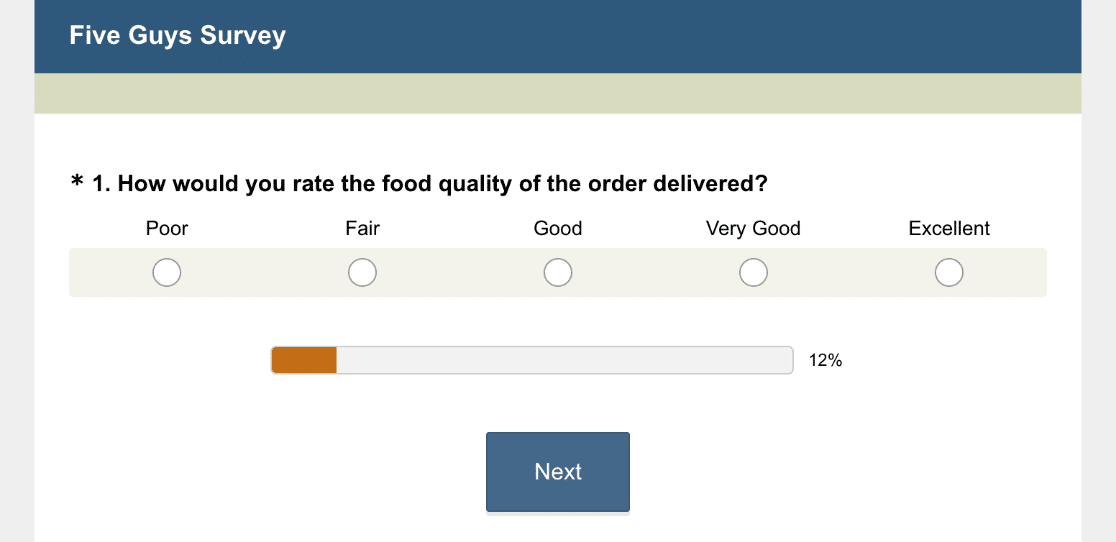
This restaurant survey uses a simple, one-question-at-a-time format, which makes it easy for customers to complete without feeling overwhelmed by seeing lots of questions all at once.
That said, using this style can sometimes feel misleading to customers if there are too many questions and no indication of the overall length. We like that this survey counteracts that with a status bar. It gives users an idea of how much time they’re committing, while also encouraging completion.
Now, let’s look at a not-so-clear example.
11. United Airlines
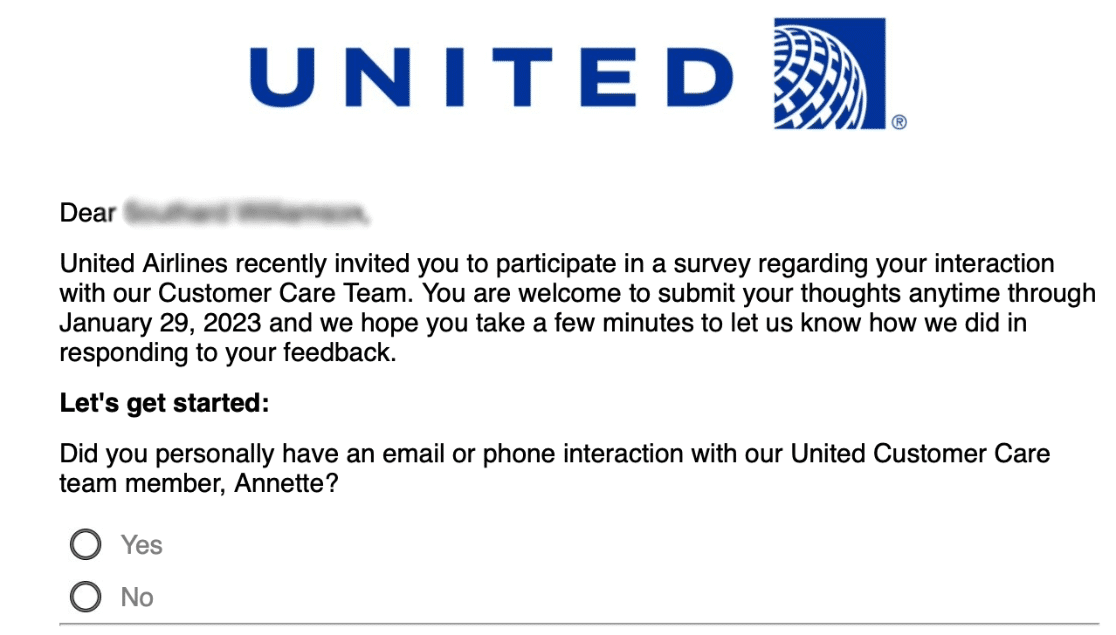
This survey from United Airlines is interesting because it combines a one-question and multi-question format. The first question is actually a link, and clicking yes will take the user to the full survey form.
On one hand, it likely increases the number of clicks, and some customers may be more inclined to fill it out now that it’s already open. But, it’s possible that others could find it unexpected and simply close out of the survey altogether.
By quickly changing formats, it somewhat undermines the conversational tone that the survey was after in the beginning.
Include Your Branding and Message in Your Surveys
If you’re using a tool like UserFeedback to display surveys on your website, this won’t be a problem since the customers are already on your site, and you can add your brand colors and logo to the popup survey.
However, if you’re using a different survey format, like email marketing, it can make or break your survey.
The best way to illustrate this is by looking at our 2 examples below. Can you tell which one will likely perform better?
12. FoundAnimals by 24Pet
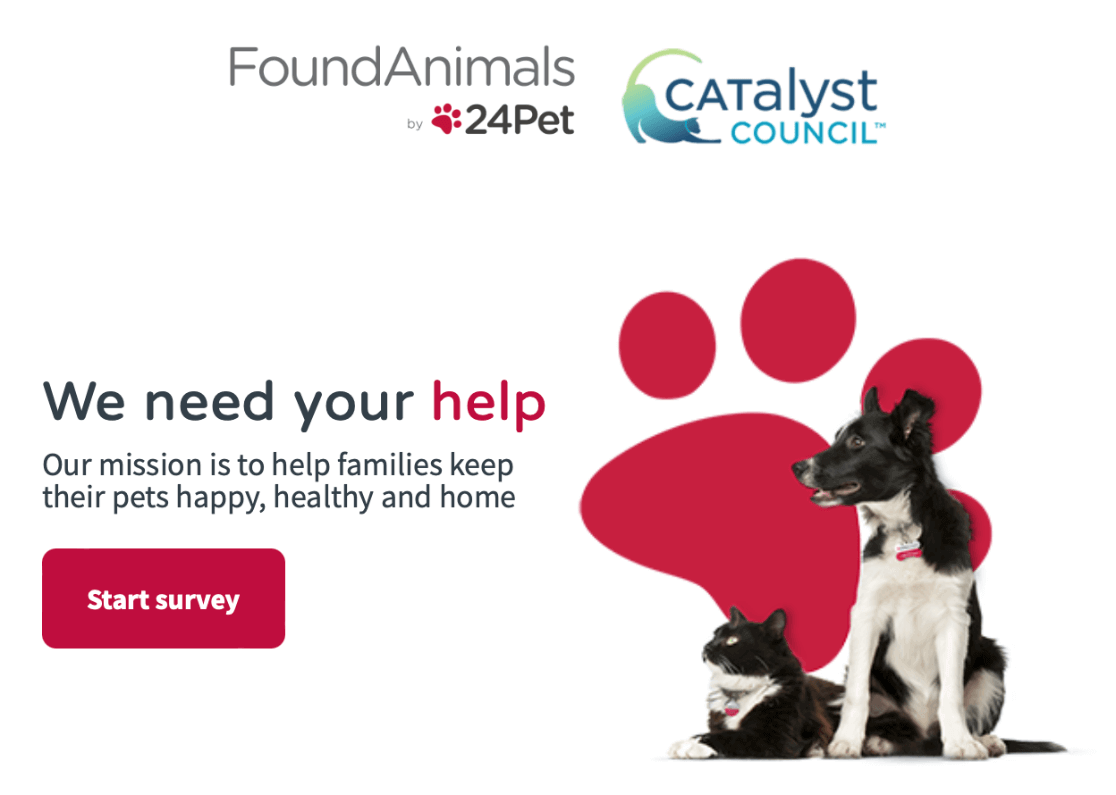
This survey is clear from the get-go. The customer instantly knows what the brand is, what they’re asking for, and what the business is about. Even without reading the text, you can quickly gather lots of context.
This style is aesthetically pleasing and helps users easily recognize your business and quickly decide if they want to take the survey.
Now, let’s look at this next survey example for comparison.
13. Modo Yoga
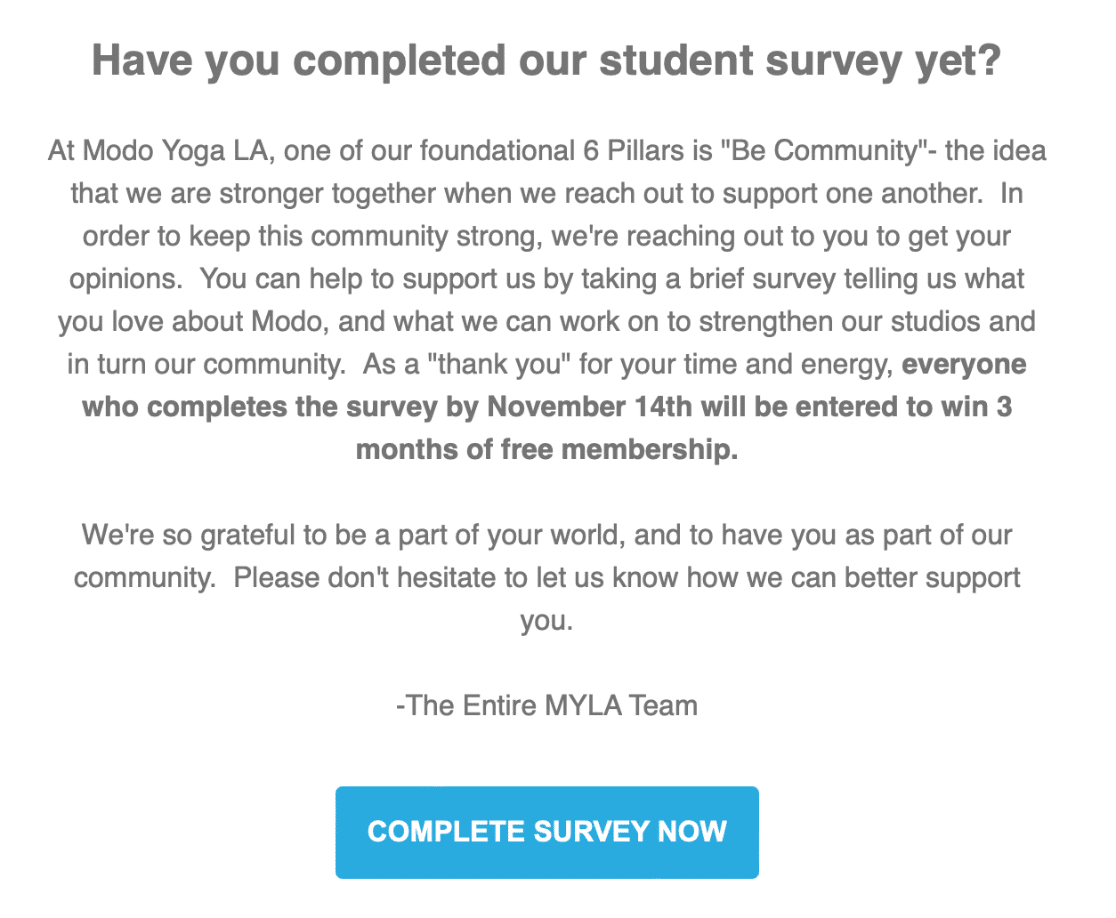
Would you know what company this is at first glance? It’s a survey for a popular chain of yoga studios.
If you read the text, you’ll actually discover that they’re offering a pretty big incentive – a 3-month membership giveaway. You’ll also find out about their values and how much they care about customer feedback, which are tips that we’ve talked about already.
In fact, this survey follows every other best practice that we’ve shown. Yet, all that good stuff is lost because the customer can’t see the information easily.
Providing easy clarity for the customer is crucial for your survey’s success and for creating an overall better customer experience.
Well, that’s it for now! We hope you’ve realized the importance of customer satisfaction feedback and found some useful templates and tips to use for your business.
Don’t forget to download UserFeedback to collect valuable customer feedback on your WordPress site and make data-driven decisions to improve your business!
If you enjoyed this article, you’ll definitely want to check out How to Reduce Bounce Rate: 7 Simple, Proven Methods
Not using MonsterInsights yet? What are you waiting for?
Don’t forget to follow us on Twitter, Facebook, and YouTube for the best WordPress tutorials and Google Analytics updates.
